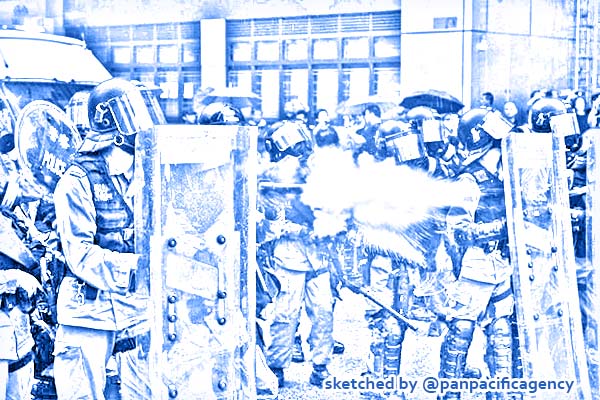China signals intervention as Hong Kong’s protests intensify

A police officer in riot gear fires tear gas at protesters during a clash in the Tsuen Wan district of Hong Kong, on Aug 25, 2019. PHOTO: NYTIMES. Sketched by the Pan Pacific Agency.
HONG KONG, Aug 26, 2019, Bloomberg. China sent the strongest warning yet of using troops on Hong Kong’s streets, where Beijing says protests have turned into a “Colour Revolution”, with water cannons and tear gas fired in skirmishes between police and demonstrators in the 12th straight weekend of unrest, reported The Straits Times.
“It’s not only the China central government’s authority but also its responsibility to intervene when riots take place in Hong Kong,” the state-run Xinhua News Agency said on Sunday (Aug 25) in a commentary, recalling comments by former top leader Deng Xiaoping that Beijing has to act under such circumstances.
United States President Donald Trump said on Aug 13 that reports from US intelligence agencies show the Chinese government is moving troops to its border with Hong Kong.
A day earlier, Global Times, a Chinese tabloid run by the People’s Daily, reported that the Chinese People’s Armed Police were assembling in Shenzhen ahead of “apparent large-scale exercises”, where “numerous” armoured personnel carriers, trucks and other vehicles of the paramilitary force were seen heading towards Hong Kong’s neighbouring city.
In Sunday’s commentary, Xinhua said Hong Kong’s protests have turned into a Colour Revolution aimed at overturning the Special Administrative Region’s constitutional institutions, a signal it was ready to take further action.
Previously, Chinese officials described the protests as having some characteristics of a “Colour Revolution”.
Protesters’ violent acts have pushed Hong Kong to an extremely dangerous edge, the city’s government said in a statement after a day full of violent clashes between demonstrators and the police, where an officer fired warning shots in the air.